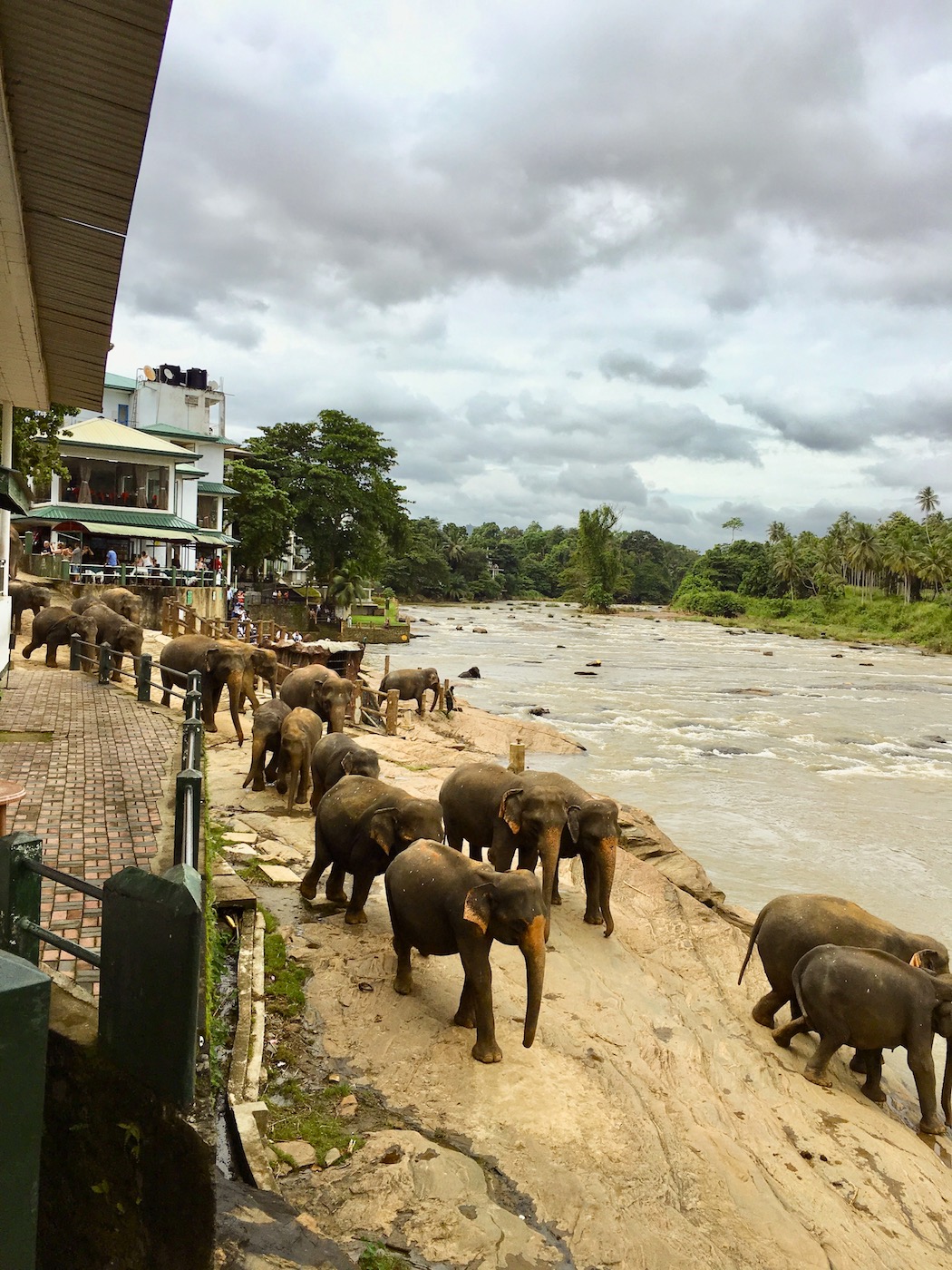Breakfast With Elephants in Sri Lanka
Breakfast with elephants in Sri Lanka. Photo: David Mattatia
Ok folks, the whole truth about this business is that being a vet myself I could not resist to the idea of planning a visit to a place called Pinnawala Elephant Orphanage.
After all, it was my very first time in Sri Lanka and the name of the place sounded so attractive!
I immediately started to imagine tiny elephants suckling out of sparkling pink baby bottles and the next thing I know is that I was including this stop in our trip while my husband was looking at me kinda horrified.
He had been to Sri Lanka some 16 years ago and as soon as he realised my excitement, he proceeded to describe the place as a "tourist trap". Mmm, okay.
Then I found some info about getting breakfast with elephants in the same area.
It sounded like a dream! We could finally see the elephants in a more natural setting. At least this is what I thought.
...but how to get breakfast with elephants?
Before getting there, I need to come back to the orphanage story.
It turns out that the elephants in the river (that appear in bucolic Instagram shots all over the internet) are the elephants from the orphanage!
Following some online research I found a lot of controversial information about Pinnawala orphanage.
Despite being a vet, I am no expert on elephants but finally decided to skip the place because indeed, they organize sessions of hand-feeding fruits by tourists and honestly, I was not keen to line-up carrying bananas in the middle of a crowd.
Bath time for Pinnawala elephants, Sri Lanka. Photo: Patti Neves
Some blogs are heavily criticizing the orphanage practices (I will leave this research up to you) but few people realize that managing these huge and strong animals is not for the faint of heart.
What I have experienced in my practice is that when the subject concerns animal welfare, most of people are very quick to judge institutions even though they don't have a clue on animal management.
Food for thought. This post is decidedly NOT about the orphanage practices nor the Sri Lanka government.
By the way, this was not a sponsorised trip. I payed every cent from my pocket to visit the country, therefore I am not promoting the orphanage or any other Sri Lanka's institution.
So the main reason why we decided to head to Pinnawala is because...
I just wanted to see the elephants playing in the river
And why? Because they are there.
And you can see them too.
You don't need to go to the orphanage if you don't want, you can simply book a room in any hotel around Maha Oya River for less than $50 dollars/night and see the best part of their day.
The elephants always come to bath in the same place (if the river is not too deep, so better to avoid the rainy season in the area).
We went on June 15th and we could see the rocks sticking out of the water. Staff in the hotel showed us some yellow marks on a few rocks, which means that the deepness was safe, so if you park around the area and don't see these marks, its very possible that elephants won't come.
Some day-trippers also just park around the area and get a free view of the river, but if you could beat the crowd, and have your little veranda for yourself, why not trying?
How to chose the hotel in Pinnawala
Pinnawala is a 3h drive from the airport. As we arrived late at night, we decided to spend the first night in Negombo. The check-in in the hotels is usually at 4pm, so if you arrive in Colombo at a decent time you can head straight to Pinnawala area if you wish.
We hired a driver, but you can try Uber or trains if you prefer (this last option can be quite exausting since there are no direct trains).
The elephants usually bath around two spots: Hotel Pinnalanda and Hotel Elephant Park. These are very close to each other.
We Stayed at Pinnalanda, as they have a big balcony (the balcony is shared with other rooms) but you can play the spoiled honeymoon couple and ask your brekkie to be served right in front of your room, in a small balcony annexed.
Obs: the best room for this trick is the number 108. You are welcome. 😘
If you use the link above to reserve your room at Hotel Pinnalanda you can specify this preference in your reservation. You will pay exactly the same thing as you would pay directly on booking.com.
Important: these are very basic hotels, please do not expect any kind of luxury. Pinnalanda is very simple, yet the room is spacious and the brekkie is ok.
Pinnalanda Hotel room, Sri Lanka. Photo: Patti Neves
What time the elephants show up at Maha Oya River?
There is a small group at 8:30 am and a big group from 10:00am to 12:00pm. Then there is another group at 2pm-4pm.
I read that the first group is composed of elephants which are on musth. This is a periodic condition affecting males, characterized by levels of testosterone 60 times greater than normal and which generally causes highly aggressive behaviour towards other elephants and men.
I didn't find any official communication from the orphanage explaining why elephants are separated by groups and which are the causes for this. Again, this is just speculation.
Finally, how were the elephants at Pinnawalla treated?
We didn't see anything shocking to be honest. We saw some elephants playing and exploring the place. Others were moving very slowly, it's true.
A group of men were taking care of the herd. Obviously some of the mahouts had poles. I read that these poles have a blind end.
My husband told me that some years ago when he visited the orphanage the majority of adult elephants were found injured, so it's possible that they don't behave completely normally compared to the healthy elephants. I could not tell the difference.
That means that some elephants at the orphanage are blind or lack body parts. Or maybe they just lost the ability of adapting back to the nature.
Its important to know that Sri Lanka is home to several natural reserves which host wild (and healthy) elephants, namely: Yala, Udawalawe, Wasgamuwa, Sinharaja, Minneriya and Kaudulla National Parks.
If you are interest in those, start by checking this nice post about Yala Park!
Arrival of elephants at Maha Oya River. Photo: Patti Neves
I prefer to believe that they would not keep the animals in a closed facility if they had the option of releasing them into the nature. The tickets that tourists buy to go on safaris in the natural parks (around $50) are much more expensive than the tickets to see them at the orphanage ($16).
So here you go. According to Pinnawala website:
Prior to the invasion of the British in Sri Lanka, around 30,000 elephants lived on the island. In the 1960s, following nearly a century of game hunting by the British colonialists, the elephant population was close to extinction. The tragedy of decimation of the elephant population prompted the Government of Sri Lanka to initiate the Pinnawala Elephant Orphanage. The number of elephants living in Sri Lankan wilderness today exceeds 3,000.
I hope this post is useful. Do you have comments or insights? Please share with us.
If you travelling around the South Coast read also this post on beach hopping in Sri Lanka: from Mirissa to Galle.
Looking for other things to see in Sri Lanka?
Other activities:
PARTNERS♡
If buy anything from my links, I’ll earn a small commission at no extra cost to you. Your support helps me keep the site going.








